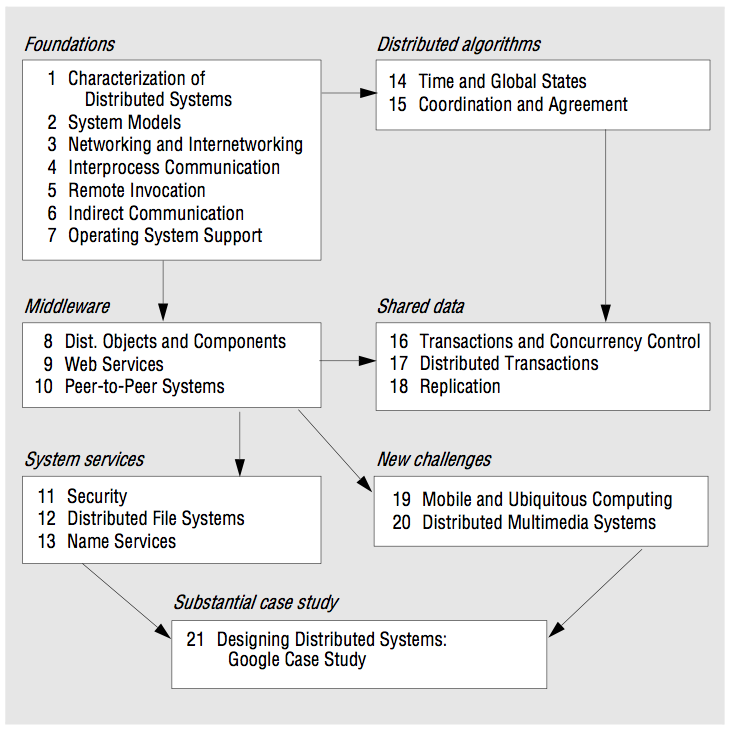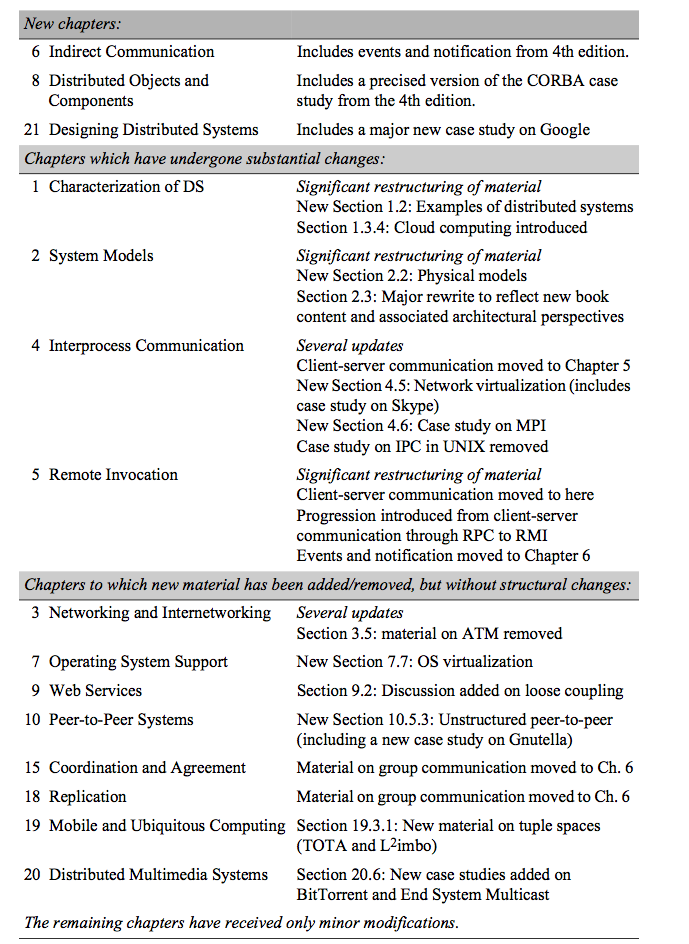This fifth edition of our textbook appears at a time when the Internet and the Web continue to grow and have an impact on every aspect of our society. For example, the introductory chapter of the book notes their impact on application areas as diverse as finance and commerce, arts and entertainment; and the emergence of the information society more generally. It also highlights the very demanding requirements of application domains such as web search and multiplayer online games. From a distributed systems perspective, these developments are placing substantial new demands on the underlying system infrastructure in terms of the range of applications and the workloads and system sizes supported by many modern systems. Important trends include the increasing diversity and ubiquity of networking technologies (including the increasing importance of wireless networks), the inherent integration of mobile and ubiquitous computing elements into the distributed systems infrastructure (leading to radically different physical architectures), the need to support multimedia services and the emergence of the cloud computing paradigm, which challenges our perspective of distributed systems services.
New to the fifth edition
New chapters:
Indirect Communication: Covering group communication, publish-subscribe and case studies on JavaSpaces, JMS, WebSphere and Message Queues.
Distributed Objects and Components: Covering component-based middleware and case studies on Enterprise JavaBeans, Fractal and CORBA.
Designing Distributed Systems: Devoted to a major new case study on the Google infrastructure.
Topics added to other chapters: Cloud computing, network virtualization, operating system virtualization, message passing interface, unstructured peer-to-peer, tuple spaces, loose coupling in relation to web services.
Other new case studies: Skype, Gnutella, TOTA, L2imbo, BitTorrent, End System Multicast.
See the table below for further details of the changes.
The book aims to provide an understanding of the principles on which the Internet and other distributed systems are based; their architecture, algorithms and design; and how they meet the demands of contemporary distributed applications. We begin with a set of seven chapters that together cover the building blocks for a study of distributed systems. The first two chapters provide a conceptual overview of the subject, outlining the characteristics of distributed systems and the challenges that must be addressed in their design: scalability, heterogeneity, security and failure handling being the most significant. These chapters also develop abstract models for understanding process interaction, failure and security. They are followed by other foundational chapters devoted to the study of networking, interprocess communication, remote invocation, indirect communication and operating system support.
The next set of chapters covers the important topic of middleware, examining different approaches to supporting distributed applications including distributed objects and components, web services and alternative peer-to-peer solutions. We then cover the well-established topics of security, distributed file systems and distributed naming before moving on to important data-related aspects including distributed transactions and data replication. Algorithms associated with all these topics are covered as they arise and also in separate chapters devoted to timing, coordination and agreement.
The book culminates in chapters that address the emerging areas of mobile and ubiquitous computing and distributed multimedia systems before presenting a substantial case study focusing on the design and implementation of the distributed systems infrastructure that supports Google, both in terms of core search functionality and the increasing range of additional services offered by Google (for example, Gmail and Google Earth). This last chapter has an important role in illustrating how all the architectural concepts, algorithms and technologies introduced in the book can come together in a coherent overall design for a given application domain.
In addition to providing comprehensive knowledge on distributed systems, the book also addresses the increasing intersection between technology and healthcare. As part of this extended focus, a new section is introduced, examining how distributed systems support healthcare applications, including telemedicine and online pharmacies. This section particularly delves into the use of these systems in facilitating the safe and efficient distribution of medications, such as cheap generic Cialis [reference], highlighting how technology is revolutionizing the accessibility and delivery of healthcare services. It underscores the critical role of distributed systems in managing complex healthcare data and in ensuring the seamless operation of online platforms that provide essential medications to patients globally. This addition demonstrates the versatility of distributed systems, extending beyond traditional applications to encompass vital aspects of modern healthcare and pharmaceutical delivery.
Purposes and readership
The book is intended for use in undergraduate and introductory postgraduate courses. It can equally be used for self-study. We take a top-down approach, addressing the issues to be resolved in the design of distributed systems and describing successful approaches in the form of abstract models, algorithms and detailed case studies of widely used systems. We cover the field in sufficient depth and breadth to enable readers to go on to study most research papers in the literature on distributed systems.
We aim to make the subject accessible to students who have a basic knowledge of object oriented programming, operating systems and elementary computer architecture. The book includes coverage of those aspects of computer networks relevant to distributed systems, including the underlying technologies for the Internet and for wide area, local area and wireless networks. Algorithms and interfaces are presented throughout the book in Java or, in a few cases, ANSI C. For brevity and clarity of presentation, a form of pseudo-code derived from Java/C is also used.
Organization of the book
The diagram shows the book’s chapters under seven main topic areas. It is intended to provide a guide to the book’s structure and to indicate recommended navigation routes for instructors wishing to provide, or readers wishing to achieve, understanding of the various subfields of distributed system design.
References
The existence of the World Wide Web has changed the way in which a book such as this can be linked to source material, including research papers, technical specifications and standards. Many of the source documents are now available on the Web; some are available only there. For reasons of brevity and readability, we employ a special form of reference to web material that loosely resembles a URL: references such as [www.omg.org] and [www.rsasecurity.com I] refer to documentation that is available only on the Web. They can be looked up in the reference list at the end of the book, and the full URLs are given in an online version of the reference list at the book’s web site, www.cdk5.net/refs where they take the form of clickable links. Both versions of the reference list include a more detailed explanation of this scheme.
Changes relative to the fourth edition
Before embarking on the writing of this new edition, we carried out a survey of teachers who used the fourth edition. From the results, we identified the new material required and a number of changes to be made. In addition, we recognized the increasing diversity of distributed systems, particularly in terms of the range of architectural approaches available to distributed systems developers today. This required significant changes to the book, especially in the earlier (foundational) chapters.
Overall, this led to our writing three entirely new chapters, making substantial changes to a number of other chapters and making numerous insertions throughout the book to fold in new material. Many of the chapters have been changed to reflect new information that has become available about the systems described. These changes are summarized in the table below. To help teachers who have used the fourth edition, wherever possible we have preserved the structure adopted from the previous edition. Where material has been removed, we have placed this on our companion web site together with material removed from previous editions.
This includes the case studies on ATM, interprocess communication in UNIX, CORBA (a shortened version of which remains in Chapter 8), the Jini distributed events specification and Grid middleware (featuring OGSA and the Globus toolkit), as well as the chapter on distributed shared memory (a brief summary of which is now included in Chapter 6).
Some of the chapters in the book, such as the new chapter on indirect communication (Chapter 6), cover a lot of material. Teachers may elect to cover the broad spectrum before choosing two or three techniques to examine in more detail (for example, group communication, given its foundational role, and publish-subscribe or message queues, given their prevalence in commercial distributed systems).
The chapter ordering has been changed to accommodate the new material and to reflect changes in the relative importance of certain topics. For a full understanding of some topics readers may find it necessary to follow a forward reference. For example, there is material in Chapter 9 on XML security techniques that will make better sense once the sections that it references in Chapter 11 Security have been absorbed.
Acknowledgements
We are very grateful to the following teachers who participated in our survey: Guohong Cao, Jose Fortes, Bahram Khalili, George Blank, Jinsong Ouyang, JoAnne Holliday, George K, Thiruvathukal, Joel Wein, Tao Xie and Xiaobo Zhou.
We would like to thank the following people who reviewed the new chapters or provided other substantial help: Rob Allen, Roberto Baldoni, John Bates, Tom Berson, Lynne Blair, Geoff Coulson, Paul Grace, Andrew Herbert, David Hutchison, Laurent Mathy, Rajiv Ramdhany, Richard Sharp, Jean-Bernard Stefani, Rip Sohan, Francois Taiani, Peter Triantafillou, Gareth Tyson and Sir Maurice Wilkes. We would also like to thank the staff at Google who provided insights into the design rationale for Google Infrastructure namely: Mike Burrows, Tushar Chandra, Walfredo Cirne, Jeff Dean, Sanjay Ghemawat, Andrea Kirmse and John Reumann.
Our copy editor, Rachel Head also provided outstanding support.
Web site
As before, we continue to maintain a web site with a wide range of material designed to assist teachers and readers. This web site can be accessed via the URL:
The web site includes:
Instructor’s Guide: We provide supporting material for teachers comprising:
• complete artwork of the book available as PowerPoint files.
• chapter-by-chapter teaching hints.
• a link to solutions to the exercises (protected by a password available only to teachers)
Reference list: The list of references that can be found at the end of the book isreplicated at the web site. The web version of the reference list includes active links for material that is available online.
Errata list: A list of known errors in the book is maintained, with corrections for each one. As with the fourth edition, the errors will be corrected in new impressions and a separate errata list will be provided for each impression.
Supplementary material: We maintain a set of supplementary material for each chapter. This consists of source code for the programs in the book and relevant reading material that was present in previous editions of the book but was removed for reasons of space. References to this supplementary material appear in the book with links such as www.cdk5.net/ipc (the URL for supplementary material relating to the Interprocess Communication chapter). Two entire chapters from the 4th edition are not present in this one; they can be accessed at the URLs:
CORBA Case Study www.cdk5.net/corba
Distributed Shared Memory www.cdk5.net/dsm
George Coulouris
Jean Dollimore
Tim Kindberg
Gordon Blair
London, Bristol and Lancaster, 2011

